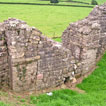Introduction
The area which now forms the south-east corner of Wales was under Roman rule for approximately three and a half centuries - the same amount of time as separates us from the Civil War. At the Roman conquest, Britain was occupied by a series of tribes, some of which were friendly to the Romans whilst others offered fierce resistance. Roman writers record that the Silures in our area were hostile and warlike, and gave them a great deal of trouble. The Roman army had reached the eastern side of Silurian territory by cAD47, but conquest was not completed until the mid 70s
Following the conquest, the Silures disappear from the histories, so what we know about them comes from the archaeology. The Roman army constructed a network of forts and roads to establish control over the area, and was initially responsible for administration. However, it was Roman policy to devolve local government to local communities as soon they could be trusted. In the early 2nd century administrative buildings - a forum and basilica (a colonnaded square with a hall separated into nave and aisles) with other buildings including a council chamber - were constructed in the new settlement of Venta Silurum (Caerwent), showing that this had taken place. The tribal council (the ordo) will have been made up of prominent local men (women were not eligible), at least some of whom were probably the sons and grandsons of the chieftains who had opposed the Roman advance. They may also have included the descendants of retired soldiers who had married into local families.
The army continued to occupy at least some of the forts into the 3rd and 4th centuries - Cardiff was rebuilt according to the latest ideas of military architecture towards the end of the 3rd century. However, we do not know whether this is because the countryside was still fairly unsettled, or whether it was just because the state needed somewhere to house the troops. Caerwent was provided with defences which were at first just a matter of civic pride, but the blocking up of the south gate, and the construction of bastions in the middle of the 4th century, suggest that by then there was a real need for fortifications. Was this due to unrest in the countryside, or a threat of raiders from across the Irish Sea? At all events, the absence of pottery and coins from most farmsteads in the second half of the 4th century suggests that either they had been abandoned, or their inhabitants had become self-sufficient and no longer needed to buy household goods.


